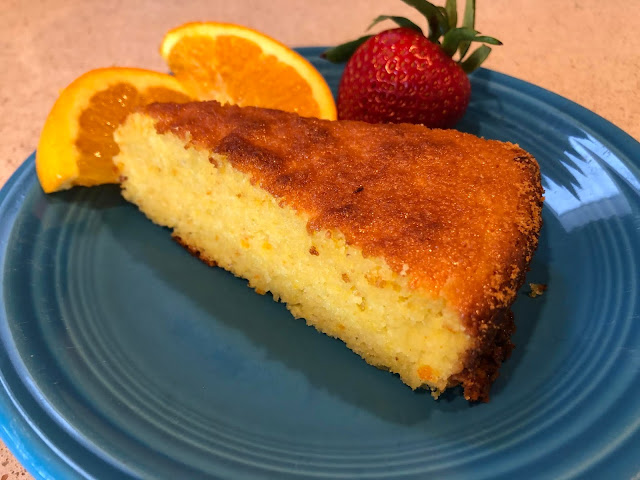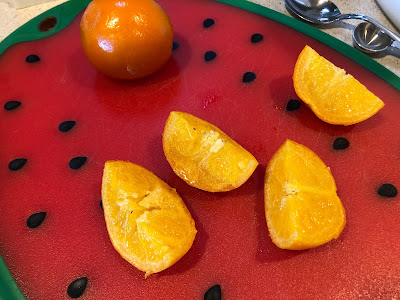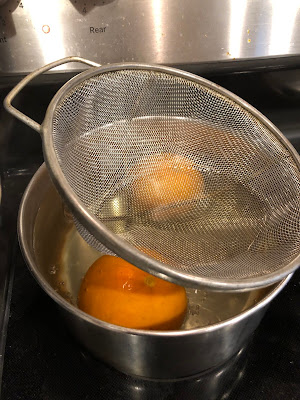
Recipe: No gluten or dairy in almond-based treat

(Photos: Kathy Morrison) |
My Washington navel orange tree still has plenty of fruit, so I'm thrilled to find more recipes that show off citrus. The lovely cake here has several bonus traits: It's gluten-free and uses no dairy products, and it easily can be dressed up for special occasions.
I chose to serve it plain, with some orange slices and strawberries on the side, for Sunday breakfast. But with some sweetened whipped cream or a fruit compote or even a Grand Marnier glaze, it would fill the role of company dessert with no problem. The texture is more like pudding cake than a standard layer cake, so it will stay moist even without adornments.

|
The trick here is the treatment of the oranges: They're scrubbed and then boiled whole for two hours. This treatment turns the pith and skin tender, removing the bitterness. The cooled oranges are whirred in a food processor or blender, then combined with the remaining ingredients and baked in a deep cake pan, preferably one with a removable base.
I'd be intrigued to try this recipe again with Meyer lemons, Cara Cara or blood oranges, or even pink grapefruit.
This recipe has its origins in Middle Eastern cooking and was published by Claudia Moren in "Everything Tastes Better Outdoors" (Knopf, 1984). It was picked up by the New York Times and later published in Kristen Miglore's " Genius Recipes ," the first cookbook from the Food52.com website (Tenspeed Press, 2015).
The NYT Cooking site is especially useful, I find, because so many home cooks try the recipes and note their adjustments and variations. In this case, a warning from several people to bake the cake at a slighter lower temperature (375 degrees F. instead of 400) and for 15 minutes less time was crucial: My cake came out perfectly golden brown at the revised time of 45 minutes.
Note: If you haven't baked with almond meal (also called almond flour), it's just finely ground almonds. You can grind your own from blanched whole almonds if you like, but I prefer the convenience. Look for almond meal in stores' natural foods bins if you don't want to spring for a whole package, such as from Bob's Red Mill.
Almond & Orange Cake
Adapted from the version in "Genius Recipes"
Serves 8-10
Ingredients:
2 large whole oranges, scrubbed
6 large eggs
2 cups plus 2 tablespoons almond meal
1 cup plus 2 tablespoons granulated sugar
1 teaspoon baking powder
1/2 teaspoon salt
Oil or butter for the pan
More ground almonds or flour, for the pan
Instructions:

the water. |
Place the clean oranges in a medium saucepan and cover with cold water. Bring water to a boil, turn the heat down to medium, and cook the oranges for 2 hours. (You might have to add some hot water during cooking if the level drops too low in the pan.) Oranges float, so I placed a metal sieve on top of the pan to keep the fruit submerged.
Drain off the water and let the oranges cool. (This can be done the day before baking; oranges can be kept at room temperature or in the refrigerator.)
When you're ready to bake, preheat the oven to 375 degrees. Grease the pan with oil or butter, then coat with almond meal or flour. (Optional if you aren't using a pan with a removable base: Grease the pan, add a parchment paper round to the bottom of the pan, then grease the paper and proceed with coating the pan with meal or flour.)
Cut open the oranges to check for and remove any seeds. Grind the orange pieces in a blender or food processor, or push them through a metal sieve, until they form a mostly smooth butter.
Beat together the orange puree and the eggs in a bowl. Stir in the almond meal, sugar, baking powder and salt, mixing thoroughly. Pour the batter into the prepared pan, smoothing the top.
Bake for 45 minutes or until golden brown and cake starts to pull away from the pan's sides. (The toothpick check does not work with this cake since it's quite moist.) Let cake cool in pan -- for at least 10 minutes if pan has a removable base, or until mostly cool if it does not. Turn out cake and let it finish cooling.
Serve plain, or with fruit, whipped cream or a thin glaze, as desired.
Comments
0 comments have been posted.Sacramento Digs Gardening to your inbox.
Food in My Back Yard Series
April 29: What's (already) wrong with my tomato plants?
April 22: Should you stock up on fertilizer? (Yes!)
April 15: Grow culinary herbs in containers
April 8: When to plant summer vegetables
April 1: Don't be fooled by these garden myths
March 25: Fertilizer tips: How to 'feed' your vegetables for healthy growth
March 18: Time to give vegetable seedlings some more space
March 11: Ways to win the fight against weeds
March 4: Potatoes from the garden
Feb. 25: Plant a fruit tree now -- for later
Feb. 18: How to squeeze more food into less space
Feb. 11: When to plant? Consider staggering your transplants
Feb. 4: Starting in seed starting
Sites We Like
Garden Checklist for week of May 4
Enjoy this spring weather – and get gardening!
* Plant, plant, plant! It’s prime planting season in the Sacramento area. Time to set out those tomato transplants along with peppers and eggplants. Pinch off any flowers on new transplants to make them concentrate on establishing roots instead of setting premature fruit.
* Direct-seed melons, cucumbers, summer squash, corn, radishes, pumpkins and annual herbs such as basil.
* Harvest cabbage, lettuce, peas and green onions.
* In the flower garden, direct-seed sunflowers, cosmos, salvia, zinnias, marigolds, celosia and asters. (You also can transplant seedlings for many of the same flowers.)
* Plant dahlia tubers. Other perennials to set out include verbena, coreopsis, coneflower and astilbe.
* Transplant petunias, marigolds and perennial flowers such as astilbe, columbine, coneflowers, coreopsis, dahlias, rudbeckia and verbena.
* Keep an eye out for slugs, snails, earwigs and aphids that want to dine on tender new growth.
* Feed summer bloomers with a balanced fertilizer.
* For continued bloom, cut off spent flowers on roses as well as other flowering plants.
* Add mulch to the garden to maintain moisture. Mulch also cuts down on weeds. But don’t let it mound around the stems or trunks of trees or shrubs. Leave about a 6-inch to 1-foot circle to avoid crown rot or other problems.